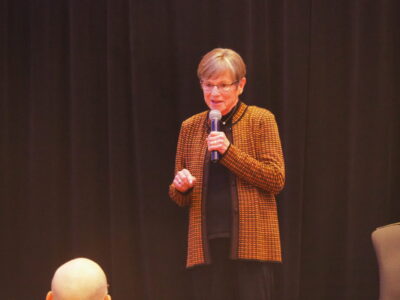The Emporia Experiment: What happened when a businessman was handed the keys to a state university
Finances have improved at ESU, but some say culture hasn't
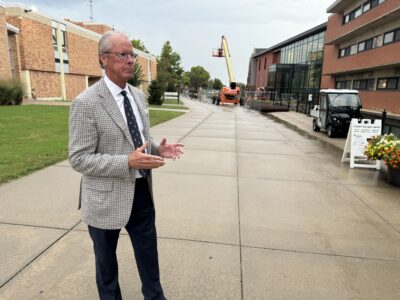
photo by: Chad Lawhorn/Journal-World
Emporia State University President Ken Hush is pictured in October 2025 next to the construction of a new campus nursing building. The building is the first new academic building at ESU since 1979, and is being constructed with no debt nor new state funding.
It had been 72 hours since Ken Hush had taken over as interim president of his alma mater, Emporia State University.
Despite growing up in Emporia, Hush wouldn’t exactly say he was comfortable in his new setting. He had spent more than 20 years as a successful executive with Wichita-based Koch Inc., in its carbon division, which is shorthand for oil, gas and other fuels that power the world.
Hush led efforts that looked beneath the ground to find new riches. Now, leaders with the Kansas Board of Regents had given him this interim job to do a different type of deep dive: Look beneath the hood of higher education.
Expenses had been rising, revenues had been falling, interest from prospective students had been waning. Plus, the date was November 2021. Everybody was coming out of the pandemic. No one knew what the new normal would be or if it would ever arrive.
But 72 hours into this venture, Hush had his first chance to pop the hood. A library dean had resigned. A room of academics was telling Hush exactly what you would expect: Let’s get moving on finding a replacement.
Hush, however, hadn’t seen any data, reviewed any metrics, or heard from department users. Koch hadn’t grown to become the second-largest private company in America without looking at the data.
So, Hush proposed another path. ESU was unique in that it actually had two library leaders on campus: One that oversaw the actual operations of the libraries, and another that oversaw the university’s school that teaches and trains librarians. Hush’s proposal was to have the one remaining library leader oversee both departments on an interim basis while he gathered more information.
In a corporate boardroom, it was an idea that likely would have been well received. In the halls of academia, the reaction was quite different.
“I was told I was not worthy,” Hush recalls. “At a louder decibel.”
The first report from the mechanic: There is a loud, concerning noise coming from the engine.
But Hush moved ahead with combining the two positions on an interim basis. The data eventually told him it was a combination that should become permanent, so it has. Now, the decision produces a businessman-like boast from the university president.
“We had our first merger within 72 hours,” he said.
It wouldn’t be the last. Nor would it be the last of the noises. Hush’s tenure at Emporia State has been marked by disruption, which reached a peak in 2022 when he used a temporary state policy to lay off a group of tenured professors, a matter that is still the subject of a federal lawsuit.
Now, Hush is in his final weeks as ESU president. He is retiring in December, and the Journal-World asked him to share what he found by looking under the hood. Among the answers:
• A university president can do “the alumni circuit and rubber chicken dinners all the time” and “fly under the radar,” for a smooth tenure. “You can keep busy all day long in meetings.”
• Students provide universities with a tremendous amount of data at least twice per year: When they enroll for classes in the fall and the spring. “Do you know what Emporia State is the proud owner of? Not looking or listening to the data at all.”
• Surprise that higher education leaders do not want to pay more attention to the fiscal matters of the industry. “There are no rewards for it, first of all.” A lack of a true profit and loss statement doesn’t create the incentive that exists in the business world to make needed changes.
“I think that is the main difference with this,” Hush said. “This is partially subsidized by the Kansas taxpayers, and the assumption is it is always going to be there.”
Come to find out, there is still noise coming from Emporia State.

photo by: Chad Lawhorn/Journal-World
Emporia State University is pictured in October 2025.
The Emporia experiment
Indeed, Hush makes statements that many academic leaders would not, and the people who hired him are unsurprised.
Hush was promoted from interim president to the school’s 18th president in June of 2022. The appointment created more noise. Hush had not ever served in a university role prior to the interim presidency, plus he hadn’t spent that much time at a university — at least not by the standard of academics. He graduated with undergraduate degrees in business administration and marketing from ESU, but has no graduate degrees.
“I knew it was controversial,” Wint Winter, a Lawrence resident who was a member of the Kansas Board of Regents during the hiring process, said of Hush’s hire. “I think we wanted to try something different.”
Then-chair of the Kansas Board of Regents Cheryl Harrison-Lee knew she wanted a different type of leader. Enrollments had consistently been falling at ESU, and finances were deteriorating. She believes Emporia State — the smallest of the state’s six public universities — was at a “crossroads.”
She wasn’t convinced a traditional academic leader would bring the right mindset to tackle the challenges.
“What was appealing was his business discipline,” Harrison-Lee said of Hush. “Business discipline means looking at measurable outcomes.”
Harrison-Lee, whose term on the Board of Regents has since ended, has kept an eye on Hush and ESU. The university in the fall semester of this year ended five years of enrollment declines, and actually posted the largest enrollment growth — by percentage — of any of the state’s public universities.
Hush would tell you that enrollment gain is not one of the most important metrics to look at, saying it doesn’t reflect the financial situation of a university. Indeed, enrollment is still lower today than at the beginning of his tenure. Rather, it is some of the more technical financial metrics that paint a picture of an organization aligning its spending with the actual demand that students are creating, he said.
Harrison-Lee has been aware of those improving metrics too, and she is proud of the hire she and her fellow regents made, even though Hush, at times, has been extremely unpopular among university faculty.
Harrison-Lee said Hush’s business background and acumen challenged university staff to really “look at how they were doing business.” It is a challenge she thinks other universities should accept. She said what has happened at ESU is evidence that universities can be “mission driven and financially sustainable.”
It requires willingness on the part of leadership to be candid and make some unpopular decisions, but she noted that “leadership is not about being liked but being responsible.” She thinks state leaders could use the experiences from ESU to make Kansas the “leader in taking a different look at how higher education institutions are run.”
“I think it has given us a model,” Harrison-Lee said. “ESU was sort of the laboratory.”
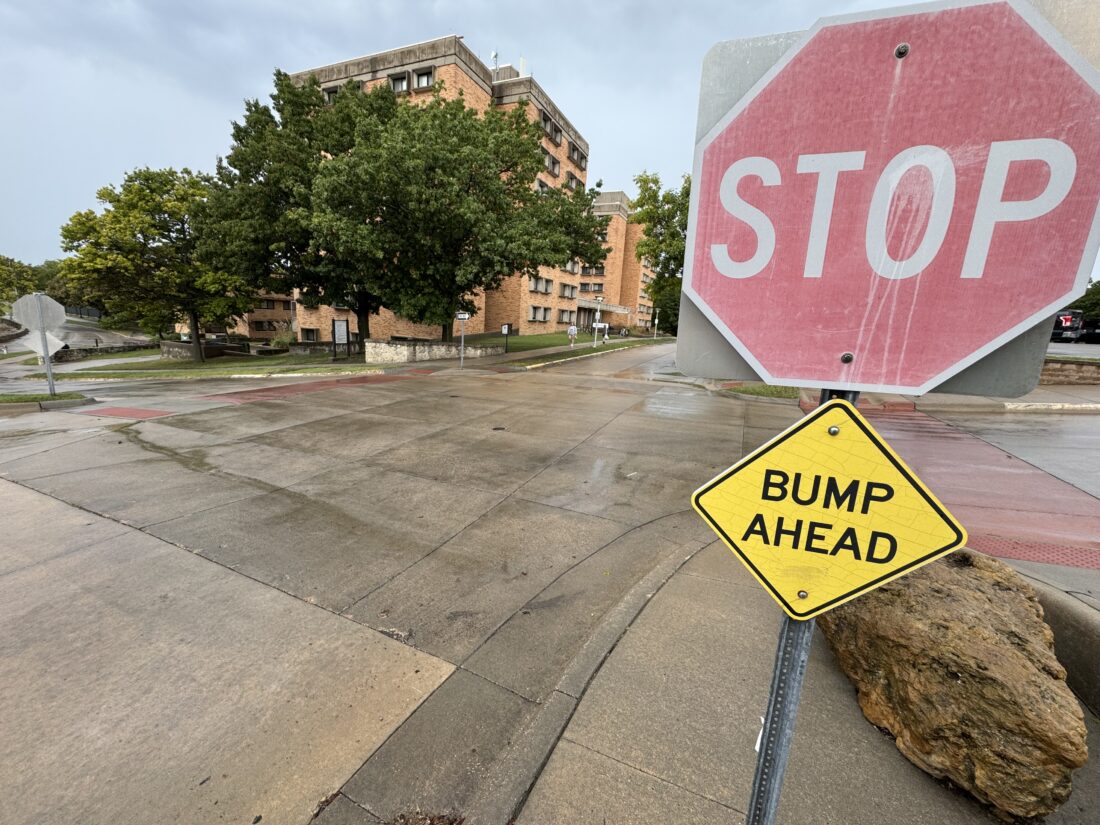
photo by: Chad Lawhorn/Journal-World
Emporia State University is pictured in October 2025.
Tenure tumult
For Michael Smith, an ESU political science professor and chair of the ESU chapter of the American Association of University Professors, those words of the Hush way being a new model might be the scariest noise to come from Emporia State.
What those who praise Hush may not understand, Smith said, is the intangible costs his approach has put upon ESU.
“Among faculty there is just this palpable, chilling effect,” Smith said.
The reason: They fear tenure no longer has much meaning.
The rank of a tenured professor — attained after years of meeting various research, teaching and other academic goals — has long come with a good amount of job protection. In general, it is difficult to fire a tenured professor unless a rigorous process is undertaken. The tenure rank also has served as an effective shield against getting fired for saying something unpopular, which can be a danger for an academic who feels the need to test boundaries in order to expand them.
Hush said if ESU had laid off tenured professors because of what they said or what boats they rocked, that would be a problem. However, he said that’s not what ESU did. Instead, Hush said approximately 30 tenured professors were terminated to solve a different type of problem: ESU had more professors than it needed for the number and type of students it had.
Hush may not have an advanced degree, but he has an advanced understanding of supply and demand from a career as a business executive. He said the law of supply and demand has been screaming at Emporia State for a decade.
“Anytime you have this much red ink for a decade plus, your supply and demand is out of whack,” Hush said, pointing to a 10-year enrollment chart that uses red ink to show enrollment declines.
Prior to this year’s recent gain in enrollment, ESU had seen a 10-year decline of about 25% in its overall enrollment, dropping its total student level to about 4,500. That broad number, though, isn’t as important as the more specific enrollments for individual programs, Hush said. He and his team reviewed those numbers in detail. Among the findings:
• The number of students seeking an undergraduate degree in economics had fallen from 30 students in 2016 to five in 2022;
• The university offered a minor in paleontology, but in 2022 only one student was seeking the minor.
• Of the 51 Geology and Earth Science classes offered in 2022, 48 of them had fewer than 10 students, which met ESU’s established definition of a low-enrollment course.
• Within the university’s art department, a concentration in sculpture was offered, but by 2022 there were no students seeking it.
Hush said he and his team used numbers like those to reduce the teaching workforce in departments that had low enrollment and were no longer deemed to be in ESU’s “strike zone.”
“It was always about programs, not people,” Hush said of how it was decided which professors would lose their jobs.
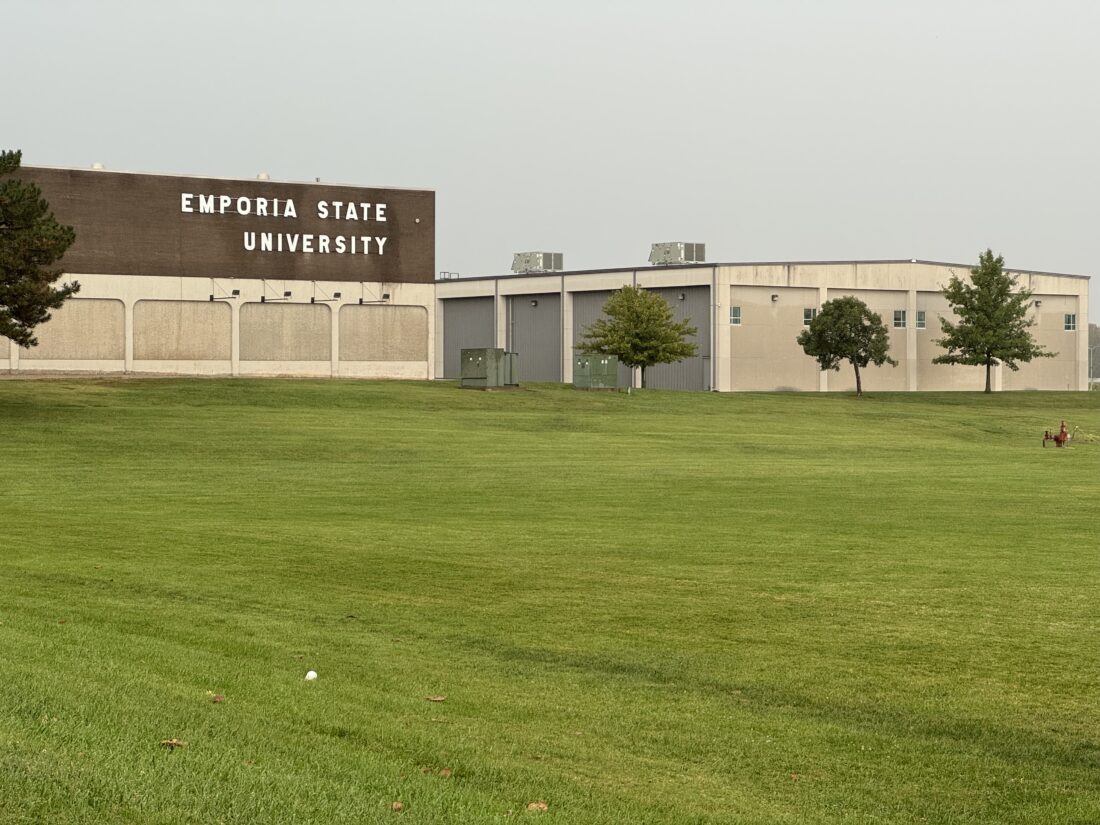
photo by: Chad Lawhorn/Journal-World
Emporia State University is pictured in October 2025.
Smith said he’s not convinced that was the case. Before the reorganization, Smith was a department chair and regularly received revenue reports related to various academic units. He contends some of the programs that were cut were producing positive revenue for the university.
He said there may be other reasons that those programs were eliminated, but he said Hush hasn’t done a good job of sharing them.
“The biggest problem with the Hush administration has been a lack of transparency,” Smith said. “Ground zero on that is here we are more than three years in, and the individuals who were dismissed on Sept. 15, 2022, we still don’t know why.
“We don’t know what criteria were used to choose those individuals and not others.”
The national AAUP organization also has echoed those concerns, and conducted an investigation that heavily criticized the process of dismissals.
Hush lists transparency as one of his core leadership principles, so chalk that issue up as another one in which the parties disagree. Regardless, the signs of a lack of trust between the administration and faculty are evident. Without more trust, it seemingly will be difficult to resolve the thorny issue of tenure and how much job protection it should provide to professors.
When asked why professors should trust that a modified tenure system wouldn’t be used to get rid of professors that the administration finds offensive, Hush simply replied that “we just don’t do that.”
What the Kansas Legislature does with tenure might be the bigger question at this point. Higher education leaders expect the next legislative session will include a bill to reduce the protections of tenure. Emporia State’s former general counsel has been among those urging lawmakers to declare that tenure is not a property right, meaning that it is not something a professor would have to be compensated for if it were lost. That property right matter is a key issue in a lawsuit that 11 former ESU professors have filed against the university and the Kansas Board of Regents. A plaintiff in that suit — Max McCoy, a former professor who was an outspoken critic of Hush — declined to comment on Hush for this article, citing the ongoing nature of the lawsuit.
While the future of tenure is a politically charged question likely to divide, it is clear higher education is facing new headwinds. There’s the potential loss of significant federal funding, and the almost certain loss of large numbers of high school graduates who could go on to become college students. A “demographic cliff” caused by lower birth rates following the 2008 Great Recession is expected to produce smaller high school graduating classes for the next decade.
Given it all, will other universities have to reduce their faculty sizes to get their own supply and demand equation in balance? University of Kansas Chancellor Douglas Girod has said weakening tenure would be extremely detrimental to KU’s ability to attract and retain quality faculty members. However, KU also is actively working to reduce the number of tenured faculty members. The university last month announced an early retirement program that is open only to tenured faculty.
Hush said it wasn’t for him to say whether other universities should use tenured faculty reductions as a method to get their financial operations in better order.
Hush, however, does say most universities are going to have to do something to stay financially sustainable. Payroll is a university’s largest expense. He said the job protections in tenure have caused universities to make some wrongheaded decisions about laying off certain staff positions — non-faculty members — simply because it is easier to terminate staff members, who don’t have tenure. At ESU, he said a previous administration reduced the number of staff members responsible for recruiting prospective students from area high schools.
“Anybody seeing a problem with that domino effect in the next two, three, five years?” Hush said.
If during his days in corporate boardrooms he would have proposed making such a cut while leaving untouched faculty positions that served just a handful of students, he suspects he wouldn’t be making many more presentations to that corporate board. To Hush, looking at faculty cuts fit with a business principle he has long employed.
“You cannot look at doing the right thing unless you take everything into consideration,” he said.

photo by: Chad Lawhorn/Journal-World
Wooster Lake and the Wooster Bridge are pictured on the Emporia State campus in October 2025.
The results
The Emporia experiment is about to come to an end. Hush’s last day is set for Dec. 17. The Regents are in the process of looking for his replacement.
So, what do the lab results say? Regents have acknowledged that the impetus in hiring Hush was to put someone in place to improve the university’s finances. On that front, the results are a bit incomplete due to how university financial reporting works. Financial statements for the university’s 2025 fiscal year — it ended June 30 — won’t be complete for another month or more. Those are the ones most likely to show the fullest impact of the cost savings related to the reorganization, which was announced in 2022 but was implemented in multi-year phases.
There is one piece of third-party validation that Hush and his team can point to in arguing that a financial turnaround is underway. The credit rating agency Moody’s upgraded ESU’s credit rating in June. Moody’s raised the university’s credit rating from a negative outlook to a stable outlook, while keeping its overall rating at the A2 level.
“Academic program restructurings, staff and faculty reductions, and other expense controls will help ESU align its budget with enrollment realities,” Moody’s said in June of its reasons for increasing the credit rating.
The restructuring — and, importantly, additional state funding — has led to a “steadily strengthened” balance sheet that has increased the amount of cash ESU has on hand to deal with unexpected events.
The state funding support has been significant in recent years. For example, state funding in fiscal year 2024 increased by more than $12 million due to several one-time funding programs, including one specifically meant to help the state’s smaller, public universities, which also include Pittsburg State and Fort Hays State.
Hush said his team doesn’t expect those special appropriations to continue forever and is building a financial structure where they won’t be needed. The 2024 financial results do show some signs of such a turnaround.
Debt levels are now at $31.2 million, down from a 2018 high of $45.7 million. Notably, ESU is constructing a new building for its nursing school without issuing any debt.
Diving even deeper into the 2024 financial statements shows an improvement in a key metric that accountants use to measure the financial flexibility of an organization. The university’s “unrestricted net position” — a measure of how many financial assets the university has available to use for any purpose needed — has grown in recent years. In 2019, before the pandemic and Hush’s tenure, unrestricted net assets totaled $14.4 million. By 2024, they had grown to $42.7 million. Some of the increase did occur in the final year of the previous ESU administration, which was during a time period when universities received large amounts of one-time federal grants to help them recover from the pandemic. Under Hush, ESU has grown its net position significantly during periods when it hasn’t received those federal funds, although state funds have helped.
In a response to questions, an ESU spokeswoman said the preliminary financial statements for 2025 show a “meaningful” increase in the university’s net position; however, those financial statements were not available for review. The spokeswoman also said that ESU leaders are projecting that the current 2026 fiscal year will end with a truly balanced budget that did not require the use of reserve funds.
Smith said he doesn’t believe Hush has been transparent enough about ESU’s financial situation, and said he wished the university would have followed a model used by nearby Missouri Western University when it went through a restructuring in 2020. Those cuts in many ways were deeper than what ESU has experienced — about a quarter of the faculty at the St. Joseph school either retired or were terminated — but Smith said they were done with a greater level of consultation than ever happened at ESU.
Smith said even if ESU’s finances have improved, he also wants observers to be aware of the culture costs that ESU has incurred.
“The way ESU is run is so much more top down,” Smith said.
But there is one easy-to-find piece of financial data that ESU leaders point to as a clear-cut success: The university has gone two consecutive years without raising tuition. It is the only public university in the state that has not increased tuition during the last two years.
In 2024, ESU originally proposed a tuition increase similar to those at other universities in the state. Then, at the last minute, Hush told Regents that ESU did not need the increase. Since 2022, ESU’s annual increase in tuition has averaged half the rate of the other state universities — 1% versus 2.5% annual increases. During that time period the university also has eliminated parking fees for students, and has increased the hourly wage for student workers by $2.25.
Hush said such decisions fit with the overall philosophy he has tried to instill at ESU.
“Why are we here? Students, students, students,” Hush said, tapping on the desk each time he said the word. “We didn’t pay attention to that. It was about preserving the institution before we started.”
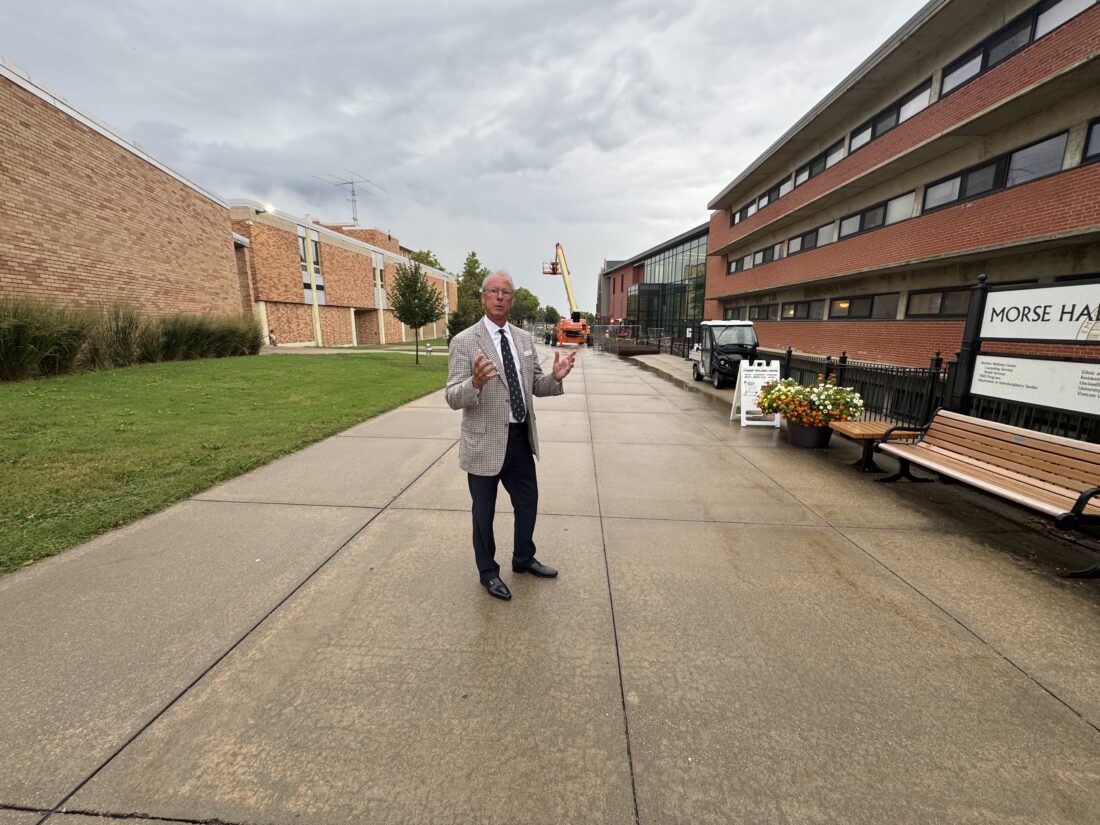
photo by: Chad Lawhorn/Journal-World
Emporia State President Ken Hush is pictured in October 2025 on the ESU campus.




